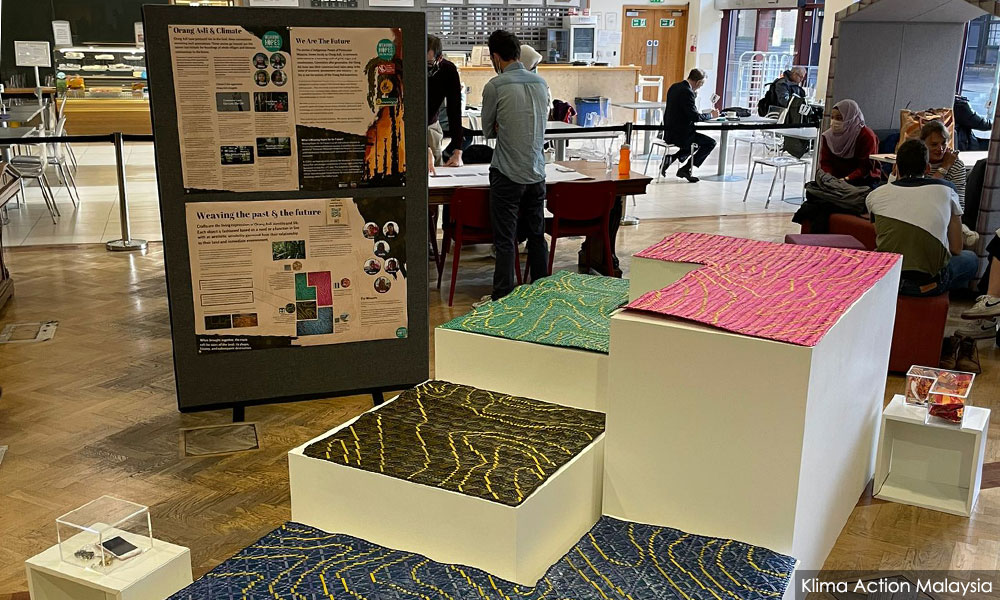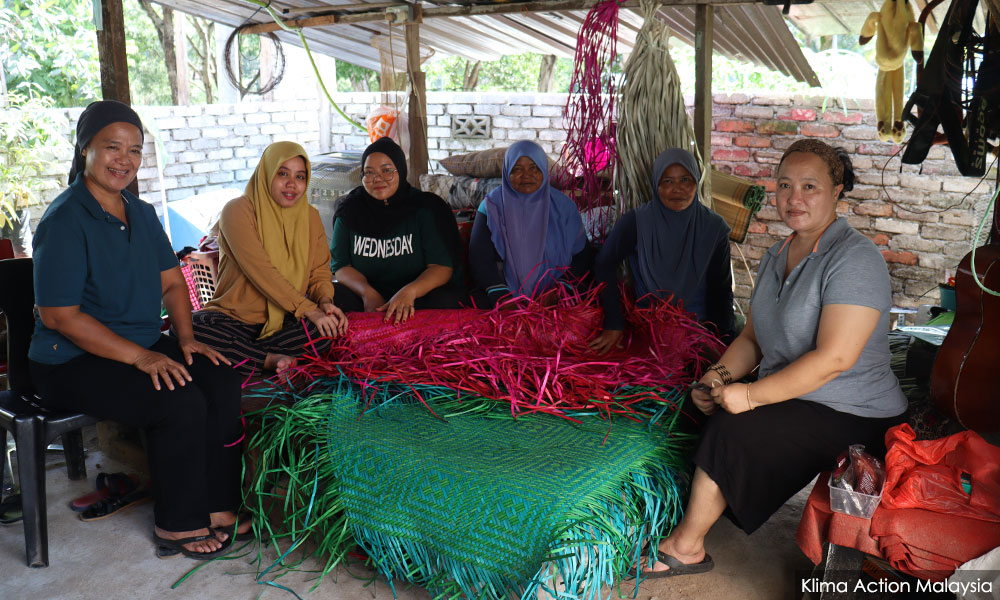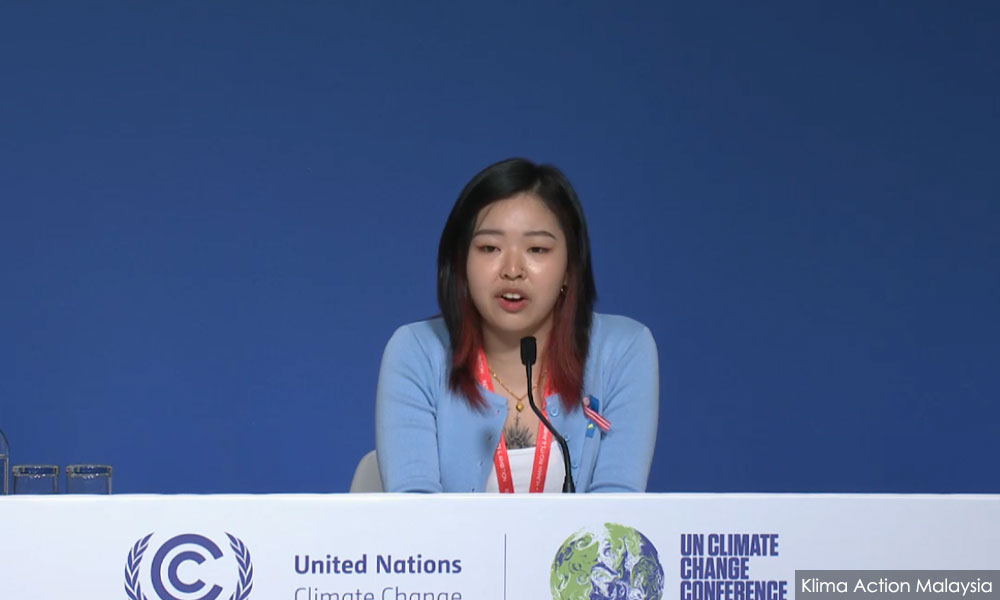The 26th United Nations Climate Change Conference (COP26) was attended by more than 100 world leaders who worked around the clock to reach the hard decisions - but at the very heart of the summit was the arts.
For the first time, members of Malaysia's indigenous community have been able to showcase their craft traditions to the global community.
Receiving a grant from the British Council earlier this year, Klima Action Malaysia (KAMY) decided to create the Weaving Hopes For The Future project - led by indigenous youth and women from Selangor and Pahang.
The project took shape in an exhibition held in Glasgow during the two weeks of COP26 negotiations earlier this month that featured a documentary and art installations involving traditional Temuan mats.
KAMY co-founder Aroe Ajoenii explained that while the delegation's Orang Asli team members did not physically attend COP26, their spirit was represented by their artworks and series of documentaries.
"Hanim Apeng and the master weavers from the Temuan tribe feel incredibly proud that their artwork creates conversations about cultural loss and climate reparations at the exhibitions.
"The Weaving Hopes four-part documentary was screened at the Glasgow Centre for Contemporary Arts. The documentary tells stories from Orang Asli women, healers, elders and activists from the Jakun tribe in Kuala Rompin of how their plight for Indigenous sovereignty is linked to the climate crisis," said Aroe, who is also the Weaving Hopes For The Future exhibition coordinator.
Creating the works
In producing the works, a team of weavers were brought together to produce an installation consisting of four large mengkuang (screwpine leaves) mats using methods based on Temuan knowledge of foraging, plant and material use, pattern designing and practice of communal weaving.
This led to the installation's use of a traditional weaving technique known as 'kelarai'.
Kelarai is a checkered weaving technique that employs a simple but beautiful arrangement of continuous, symmetrical squares to produce motifs based on native flowers, fruits and animals.

Intended to be viewed as "a message of urgency and hope", each of the four mats was woven in various colours to represent a specific industrial activity driving the shift in the country's natural forests that threaten the Orang Asli way of life.
Green represented timber harvesting, red for mono-crop plantations, brown for mining, and blue for mega infrastructure projects.
On top of the kelarai weave are embroidered topographical patterns which map the texture of the land devastated by clear-cut logging.
When shown side by side, the mats share the story of the land: its shape, history, and subsequent destruction.
Closely associated with the home and community, crafts are central to Orang Asli identity and life. Each object is designed functionally, taking into account one's relationship to their land and immediate surroundings.
However, weaving mats using mengkuang leaves is a tradition that is becoming increasingly inaccessible to the Orang Asli communities.
Ili Nadiah of KAMY explained that screwpine leaves were becoming harder to find - a symptom of a much greater issue.
"For the weavers, it is no easy work to forage for mengkuang leaves. The scarcity of mengkuang is a symptom of the greater issue of customary land loss for Orang Asli communities.
"By losing their ancestral lands, Orang Asli communities are not just losing raw material for craft making; they are losing their capacity to plant, hunt, fish and gather what they need sustainably.
"The connection to the land is severed. This means the loss of tradition and history, their homes and way of life, and Indigenous knowledge. Cultural and identity death reduces community resilience to facing future shocks that include climate impacts," she told Malaysiakini.

Summit was the right platform
Aroe said that the biggest challenge the group faced was running this project throughout the pandemic and multiple lockdowns.
"We had to adapt and organise Zoom meetings with our Indigenous team and international partners for the past 11 months.
"The weaving process and filming were also postponed many times due to rising cases in the Orang Asli villages we worked with.
"On top of that, uncertainties about COP26 on whether it will happen was a big risk, so we had to plan for alternatives. We also ran a public fundraising effort to help us deal with the logistical expenses to COP26 to mitigate the risk of Covid-19 and the rising costs in Glasgow.
Members of the team behind the Weaving Hopes for the Future documentary Norifa Jamiza Jamil and Eliana Tan felt that despite the challenges they faced, the summit was the right platform to convey the concerns of their community in Rompin, Pahang.
"When we were brainstorming for the documentary, we sketched storyboards, visualised the direction, and figured out how to convey the message to our audience in Glasgow.
"Our movement was also limited; we could only film in our village area. Due to the enhanced movement control order, we had to change a lot of our shooting locations and subjects from the initial plan. This change delayed most of our progress.
"We quickly noticed that our subjects experienced difficulties understanding the term 'climate crisis' or 'climate change' due to a lack of prior knowledge, but they quickly caught on after we explained it to them, and they could answer most of our interview questions smoothly," said the indigenous youths.
The youths expressed their hopes to see more Orang Asli youth inspired to speak up in their villages on the climate crisis and environmental issues.
"The Orang Asli community, especially the youth and women, must be empowered and leading the climate movement, and we should act now because the Orang Asli are at the frontlines of the climate crisis.
"The youth have a significant role; we need to support and disseminate knowledge about the climate crisis to the public, even more so to our communities, so that this oppression and injustice end and our decisions be respected.
"We are the people who take care of the forest and the environment, and our connection to the land can help drive sustainable solutions for Malaysia's natural resources consumption," said Tan and Norifa.
COP26 failed to meet expectations
From ministers standing knee-deep in seawater to demonstrate their nation's struggles against rising sea levels to staged walk-outs by campaigners, many expressed their disappointment at the outcome of the two-week-long summit - with a consensus that this year's targets were insufficient to prevent the devastating effects of climate change.
Aroe told Malaysiakini that one of the key promises - the US$100 billion (RM420 billion) climate financing that many countries anticipated - had been pushed to 2023.
"So this is what Glasgow Climate Pact looks like; watered-down commitments to "phase-down" coal, loopholes bowing down to fossil fuel interests, missing finance requirements in Loss and Damage, and a disregard for justice and safeguards for local communities in market-based solutions.
"With these outcomes, countries still failed to reach an agreement to keep our temperature below 1.5 degrees Celsius.
"We are heading towards a 2.4 degrees Celsius hotter world, an outcome different from what the vulnerable communities in the Global South are expecting," said Aroe.

Additionally, KAMY vice-chair Hailey Tan said that many from the Global South felt excluded from discussions, especially for those who did not attend due to vaccine discrimination and problems with obtaining a travel visa.
She said the most apparent commonality with Most Affected People and Areas (Mapa) countries is the shared experience of living through the climate crisis that is already happening.
"The devastation of floods, droughts, forest fires, and other phenomena has greatly affected our communities. And yet, as we speak about it and call out those responsible, we aren't taken seriously.
"Our common goal is to ensure world leaders, especially in the Global North, take proper action to mitigate the climate crisis as they have been historically responsible for the emissions.
"We must call out their inaction and amplify the voices of the vulnerable, so we can stand together to demand accountability for the loss and damage caused by the Global North leadership," she said
The COP is an annual conference where governments sign deals to keep global temperature by the turn of the century below two degrees Celsius, compared to pre-industrial levels.
The conference's core aim was to sustain the 2015 Paris Agreement's aspirational target holding the increase in the global average temperature to well below 2.0 degrees Celsius above pre-industrial levels and pursuing efforts to limit the temperature increase to 1.5 Celsius above pre-industrial levels
The conference's 26th iteration was held in Glasgow from Oct 31 to Nov 12 this year.
To find out more about the Weaving Hopes For The Future exhibition, check out their website here. - Mkini



No comments:
Post a Comment
Note: Only a member of this blog may post a comment.